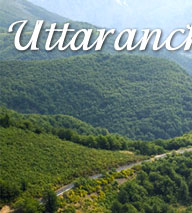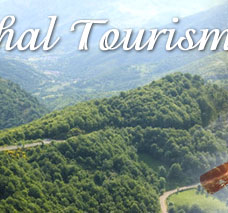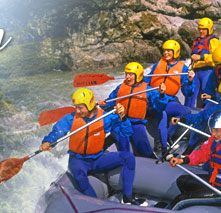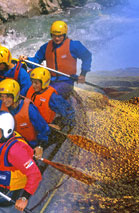Uttaranchal
Tourism –» Wildlife of Kumaon
Wildlife of Kumaon
Corbett National Park

India's
first and finest park spread over 520 sq. kms. along the banks of the Ramganga
river, just 300 kms. northeast of Delhi in the foothills of the Himalayas is
the Corbett National Park. Established initially as Hailey National Park on
August 8, 1936, in honour of Sir Malcolm Hailey, then governor of the United
Provinces, the name was changed to Ramganga National Park in 1952. In 1957,
it was finally named as Corbett National Park in honour and memory of the latc
Jim Corbett, the legendary hunter, naturalist-turned-author and photographer
who had helped in setting up the park and demarcating its boundaries. Corbett
is regarded as one of the true bird parks of the world. Out of the 2,060 species
and subspecies of birds recorded in the Indian subcontinent, over 600 species/subspecies
of birds have been recorded from Corbett at one time or another. This number
is greater than the total number of bird species found in Europe and represents
around one fourth of the available diversity found in India. Out of the 69 species
of raptors found in India, 49 can be seen in Corbett making it a striking element
of the local avifauna. The reserve, which covers 520 sq. kms. is not less than
a paradise for bird-watchers. European bird-watchers are some of the keenest
visitors to the reserve during winters when the bird diversity is at its peak.Birds
which can be spotted at the banks of River Ramganga on the outskirts of Corbett
Park include Brown Fish Owl, Himalayan Kingfisher, Brown Dipper and Plumbeous/White-Capped
Redstarts. One can also see Little/Staty backed Forktails and Mountain/Rufousbellied
Hawk-Eagles here. Inside Corbett Park, Blue Whistling Thrush and Red Jungle
Fowl are immediate possibilities. But with some efforts one can spot Oriental
White-eye, Jungle Owlet, Alexandrine Parakeet, Himalayan Swiftlet, Lesser Fish-Eagle
or even Great Thick-knee, Stork-billed Kingfisher and many more. Mammals include
Tiger, Indian Elephant, Chital, Sambhar, Muntjack (Barking Deer), Hog Deer and
Common Langur. A trip to these magnificent Sanctuaries will also take you through
Jaipur (Pink City) and Agra (City of Taj) which will add the experience of Indian
culture, heritage, history and hospitality to your memories.
With elevations in the Park ranging from 400m to 1210m there is a rich diversity
in habitat. Animals of the Himalayas and those of peninsular India can both
be seen here and over 50 mammal and 25 reptile species have been recorded at
Corbett. Among the predators are the tiger, leopard, diverse species of lesser
cats and the dhole - the wild dog.
General Information
Area : 520.8sq.km.
Altitude : Between 400mt and 1,100mt.
Temperature : Summer: 46°C 19°C & Winter:
25°C 4°C
Main entry point : Dhangarhi, Main Tourist Centre
& Dhikala.
Tourist Season : Nov. 15 to June15
Nanda Devi National Park
Spread over an area of 630 sq. kms., just next to the Nanda Devi Peak (which
is the second highest mountain in India -7816 mts.), is the Nanda Devi National
Park. It was established in 1980. The first men on record to have reached this
Sanctuary, while yet in its pristine form, were the the British Mountaineers
Eric Shipton and Bill Tilman. The area had largely remained undisturbed till
then, except for Tilman's successful attempt on Nanda Devi in 1936. However,
from 1950 onwards the increasing number of treks & climbing expeditions
to the area has somewhat affected the virgin character of this place. A unique
mix of flora and fauna is characteristic of this park. The fauna inlcudes the
brown and Himalayan black bears, Himalayan thar, snow leopards, serow and chir
pheasants.
General Information
Area : 630 sq. kms.
Altitude : Bewteen 2,400 mts. and 6,817 mts.
Raja Ji National Park

It
is the biggest park of Uttaranchal Surrrounded by mountains, Dehradun endures
as a perfect retreat with beautiful spots for picnic and excursions. Its pleasent
climate adds further to its charm and makes it an attractive tourist destination.
Established in 1996 on the edge of the Dehradun valley is Rajaji National Park,
covering an area of approx 820sq.kms. The wildlife here includes elephant, tiger,
panther, bear, chital, sambar, wild boar, kakar, python, monitor lizard and
a large variety of avian fauna. You find many opportunities of viewing these
animals in their natural habitat here.
General Information
Area : 820sq.km.
Altitude : 300 to 1350 mts.
Tourist Season : Nov.15 to june 15
Govind Wildlife Sanctuary
The Govind Wildlife Sanctuary, situated in the Uttarkashi district of Uttar
Pradesh,was established in 1955. Spread over an area of 957,969 sq. kms.,
the altitude varies from 1300 mts.to 6323 mts. The entire area of the sanctuary
is subjected to light-heavy snowfall. The snow leopard inhabits the inner
Himalayas above the altitude of 3500 mts. To improve the protection of this
rare animal, the upper reaches of the sanctuary were notified as a National
Park which covers an area of 472.08 sq. kms.
Binsar Wildlife Sanctuary
The Binsar wild life sanctuary encompasses an area of about 50 sq. Kms in
the middle Himalaya near Almora. This tract is considered to be one of the
most beautiful tracts in kumaon. The slopes vary from step to very step. The
terrain has been shaped by the action of running water. The climatic conditions
prevailing in the Binsar sanctuary range from temperate to sub-arctic. Winters
are very cold and Heavy snowfall is received.
The main forests types found in this sanctuary are listed below :
• Oak and moist mixed deciduous forests.
• Temperate moist coniferous forests including
deodar and blue pine.
• Sub-alpine birch, fir and spruce forests.
• Sub-alpine pasture and scrub.
This sanctuary is the home of many high altitude species of animals and birds
which includes the leopard, civet cat, serow, gharial, musk deer, brown bear
and khaliji pheasant.
Places Of Interest :
Jageshwar Temple
65 kms from the resort is Jageshwar, the temple town. It is situated in a
beautiful narrow valley surrounded by magnificent Deodar trees. Most of the
temples here are dedicated to the various manifestations of Lord Shiva.
Getting There :
Nearest Railhead : Kathgodam (75km from the resort)
Nearest Airport : Delhi : 383 kms (10 hrs from
the resort)
Askot Sanctury
Pithoragarh, the picturesque hill district of Uttaranchal Pradesh, houses amidst
its greens, the Askot Sanctuary, which adds more dazzle to its already splendid
beauty. Lying in the lap of Kumaon Himalayas at a height of 5412 ft., snow-capped
mountains peaks and fine temples are an integral part of Pithoragarh. The highlights
of the sanctuary are snow leopards, Himalayan black bears, musk deers, snow
cocks, tahra, bharals, monals, chirs, koklas,pheasants and chukors.
TOUR ENDS WITH SWEET MEMORIES TAKE HOME
Wildlife of Kumaon, Wildlife in Uttaranchal
Reservation Form








 India's
first and finest park spread over 520 sq. kms. along the banks of the Ramganga
river, just 300 kms. northeast of Delhi in the foothills of the Himalayas is
the Corbett National Park. Established initially as Hailey National Park on
August 8, 1936, in honour of Sir Malcolm Hailey, then governor of the United
Provinces, the name was changed to Ramganga National Park in 1952. In 1957,
it was finally named as Corbett National Park in honour and memory of the latc
Jim Corbett, the legendary hunter, naturalist-turned-author and photographer
who had helped in setting up the park and demarcating its boundaries. Corbett
is regarded as one of the true bird parks of the world. Out of the 2,060 species
and subspecies of birds recorded in the Indian subcontinent, over 600 species/subspecies
of birds have been recorded from Corbett at one time or another. This number
is greater than the total number of bird species found in Europe and represents
around one fourth of the available diversity found in India. Out of the 69 species
of raptors found in India, 49 can be seen in Corbett making it a striking element
of the local avifauna. The reserve, which covers 520 sq. kms. is not less than
a paradise for bird-watchers. European bird-watchers are some of the keenest
visitors to the reserve during winters when the bird diversity is at its peak.Birds
which can be spotted at the banks of River Ramganga on the outskirts of Corbett
Park include Brown Fish Owl, Himalayan Kingfisher, Brown Dipper and Plumbeous/White-Capped
Redstarts. One can also see Little/Staty backed Forktails and Mountain/Rufousbellied
Hawk-Eagles here. Inside Corbett Park, Blue Whistling Thrush and Red Jungle
Fowl are immediate possibilities. But with some efforts one can spot Oriental
White-eye, Jungle Owlet, Alexandrine Parakeet, Himalayan Swiftlet, Lesser Fish-Eagle
or even Great Thick-knee, Stork-billed Kingfisher and many more. Mammals include
Tiger, Indian Elephant, Chital, Sambhar, Muntjack (Barking Deer), Hog Deer and
Common Langur. A trip to these magnificent Sanctuaries will also take you through
Jaipur (Pink City) and Agra (City of Taj) which will add the experience of Indian
culture, heritage, history and hospitality to your memories.
India's
first and finest park spread over 520 sq. kms. along the banks of the Ramganga
river, just 300 kms. northeast of Delhi in the foothills of the Himalayas is
the Corbett National Park. Established initially as Hailey National Park on
August 8, 1936, in honour of Sir Malcolm Hailey, then governor of the United
Provinces, the name was changed to Ramganga National Park in 1952. In 1957,
it was finally named as Corbett National Park in honour and memory of the latc
Jim Corbett, the legendary hunter, naturalist-turned-author and photographer
who had helped in setting up the park and demarcating its boundaries. Corbett
is regarded as one of the true bird parks of the world. Out of the 2,060 species
and subspecies of birds recorded in the Indian subcontinent, over 600 species/subspecies
of birds have been recorded from Corbett at one time or another. This number
is greater than the total number of bird species found in Europe and represents
around one fourth of the available diversity found in India. Out of the 69 species
of raptors found in India, 49 can be seen in Corbett making it a striking element
of the local avifauna. The reserve, which covers 520 sq. kms. is not less than
a paradise for bird-watchers. European bird-watchers are some of the keenest
visitors to the reserve during winters when the bird diversity is at its peak.Birds
which can be spotted at the banks of River Ramganga on the outskirts of Corbett
Park include Brown Fish Owl, Himalayan Kingfisher, Brown Dipper and Plumbeous/White-Capped
Redstarts. One can also see Little/Staty backed Forktails and Mountain/Rufousbellied
Hawk-Eagles here. Inside Corbett Park, Blue Whistling Thrush and Red Jungle
Fowl are immediate possibilities. But with some efforts one can spot Oriental
White-eye, Jungle Owlet, Alexandrine Parakeet, Himalayan Swiftlet, Lesser Fish-Eagle
or even Great Thick-knee, Stork-billed Kingfisher and many more. Mammals include
Tiger, Indian Elephant, Chital, Sambhar, Muntjack (Barking Deer), Hog Deer and
Common Langur. A trip to these magnificent Sanctuaries will also take you through
Jaipur (Pink City) and Agra (City of Taj) which will add the experience of Indian
culture, heritage, history and hospitality to your memories. It
is the biggest park of Uttaranchal Surrrounded by mountains, Dehradun endures
as a perfect retreat with beautiful spots for picnic and excursions. Its pleasent
climate adds further to its charm and makes it an attractive tourist destination.
Established in 1996 on the edge of the Dehradun valley is Rajaji National Park,
covering an area of approx 820sq.kms. The wildlife here includes elephant, tiger,
panther, bear, chital, sambar, wild boar, kakar, python, monitor lizard and
a large variety of avian fauna. You find many opportunities of viewing these
animals in their natural habitat here.
It
is the biggest park of Uttaranchal Surrrounded by mountains, Dehradun endures
as a perfect retreat with beautiful spots for picnic and excursions. Its pleasent
climate adds further to its charm and makes it an attractive tourist destination.
Established in 1996 on the edge of the Dehradun valley is Rajaji National Park,
covering an area of approx 820sq.kms. The wildlife here includes elephant, tiger,
panther, bear, chital, sambar, wild boar, kakar, python, monitor lizard and
a large variety of avian fauna. You find many opportunities of viewing these
animals in their natural habitat here.